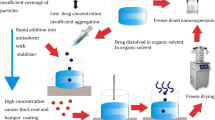Abstract
Purpose. This study was carried out to show the effect of particle size reduction and bioadhesion on the dissolution and relative bioavailability of dicumarol.
Methods. Formulations were produced by a variety of methods including a novel technique to reduce particle size as well as phase inversion with poly(fumaric-co-sebacic)anhydride p(FA:SA) to create nanospheres. Drug was administered to groups of pigs and rats via oral gavage of a suspension, and dicumarol concentration in the blood was measured using a double extraction technique.
Results. In vitro results showed improved dissolution in both the micronized formulation and the encapsulated p(FA:SA) nanospheres. In vivo, relative bioavailability of a spray-dried formulation was increased by 17% in the rat and 72% in the pig by further reduction in particle size. The bioadhesive p(FA:SA) formulation also improved relative bioavailability over the spray-dried drug, increasing it by 55% in the rat and 96% in the pig. Additionally, the p(FA:SA) formulation prolonged Tmax and decreased Cmax in both species.
Conclusion. This work demonstrates the importance of particle size and bioadhesion to improve oral bioavailability of ducumarol.
Similar content being viewed by others
REFERENCES
C. Leuner and J. Dressman. Improving the drug solubility for oral delivery using solid dispersions. Eur. J. Pharm. Biopharm. 50:47–60 (2000).
A. A. Noyes and W. R. Whitney. The rate of solution of solid substances in their own solutions. J. Am. Chem. Soc. 19:930–934 (1897).
T. Loftsson and M. E. Brewster. Pharmaceutical application of cyclodextrins. 1. Drug solubilisation and stabilization. J. Pharm. Sci. 85:1017–1025 (1996).
D. Hoerter and J. B. Dressman. Influence of physicochemical properties on dissolution of drugs in the gastrointestinal tract. Adv. Drug Deliv. Rev. 25:3–14 (1997).
A. H. Goldberg, M. Gibaldi, and J. L. Kanig. Increasing dissolution rates and gastrointestinal absorption of drugs via solid solutions and eutectic mixtures II—experimental evaluation of a eutectic mixture: urea–acetaminophen system. J. Pharm. Sci. 55:482–487 (1966).
B. C. Hancock and G. Zografi. Characteristics and significance of the amorphous state in pharmaceutical systems. J. Pharm. Sci. 86:1–12 (1997).
M. J. Grau, O. Kayser, and R. H. Muller. Nanosuspensions of poorly soluble drugs—reproducibility of small scale production. Int. J. Pharm. 196:155–157 (2000).
A. T. Serajuddin. Solid disperion of poorly water-soluble drugs: early promises, subsequent problems, and recent breakthroughs. J. Pharm. Sci. 88:1058–1066 (1999).
E. Lee, S. Lee, H. Choi, and C. Kim. Bioavailability of cyclosporin A dispersed in sodium lauryl sulfate-dextrin based solid microspheres. Int. J. Pharm. 218:125–131 (2001).
S. M. Khoo, C. J. Porter, and W. N. Charman. The formulation of halofantrine as either non-solubilizing PEG 6000 or solubilizing lipid based solid dispersions: physical stability and absolute bioavailability assessment. Int. J. Pharm. 205:65–78 (2000).
D. E. Chickering, J. S. Jacob, T. A. Desai, M. Harrison, W. P. Harris, C. N. Morrell, P. Chaturvedi, and E. Mathiowitz. Bioadhesive microspheres: III. An in vivo transit and bioavailability study of drug-loaded alginate and poly(fumaric–co-sebacic anhydride) microspheres. J. Control. Release 48:35–46 (1997).
P. E. Macheras and C. I. Reppas. Studies on drug-milk freeze-dried formulation I: bioavailability of sulfamethizole and dicumarol. J. Pharm. Sci. 75:692–696 (1986).
A. Domb and R. Langer. Polyanhydrides. I. Preparation of high molecular weight polyanhydrides. J. Poly. Sci. 25:3373–3386 (1987).
A. J. Domb, F. C. Gallardo, and R. Langer. Polyanhydrides. 3. Polyanhydrides based on aliphatic–aromatic diacids. Macromolecules 22:3200–3204 (1989).
A. Domb, E. Mathiowitz, E. Ron, S. Giannos, and R. Langer. Polyanhydrides. IV. Unsaturated polymers composed of fumaric acid. J. Poly. Sci. 29:571–579 (1991).
M. Akers, J. Lach, and L. Fischer. Bioavailability of dicumarol from different commericial tablets in dogs. J. Pharm. Sci. 62:1192–1193 (1973).
R. Nagashima, G. Levy, and E. Nelson. Comparative pharmacokinetics of coumarin anticoagulants I. J. Pharm. Sci. 57:58–67 (1968).
A. J. Quick. The prothrombin consumption time test. Am. J. Clin. Pathol. 45:105–109 (1966).
A. Creskoff, T. Fitz-Hugh, and E. Farris. Hematology of the rat—methods and standards. In E. Farris and J. Griffith (eds.), The Rat in Laboratory Investigation, Lippincott, Philadelphia, Pennsylvania, 1949, p. 413.
E. Mathiowitz, J. S. Jacob, Y. S. Jong, and G. P. Carino. Biologically erodable microspheres as potential oral drug delivery systems. Nature 386:410–414 (1997).
C. Santos, B. Freedman, K. Leach, D. Press, M. Scarpulla, and E. Mathiowitz. Poly(fumaric–co-sebacic anhydride). A degradation study as evaluated by FTIR, DSC, GPC and X-ray diffraction. J. Control. Release 60:11–22 (1999).
D. Chickering, J. Jacob, and E. Mathiowitz. Bioadhesive microspheres: II. Characterization and evaluation of bioadhesion involving hard, bioerodible polymers and soft tissue. Reactive Polymers 25:189–206 (1995).
D. Chickering and E. Mathiowitz. Bioadhesive microspheres: I. A novel electrobalance-based method to study adhesive interactions between individual microspheres and intestinal mucosa. J. Control. Release 34:251–261 (1995).
D. Chickering, J. Jacob, and E. Mathiowitz. Poly(fumaric–co-sebacic) microspheres as oral drug delivery systems. Biotechnol. Bioeng. 52:96–101 (1996).
D. Chickering, J. Jacob, T. Desai, M. Harrison, W. Harris, C. Morrell, P. Chaturvedi, and E. Mathiowitz. Bioadhesive microspheres: III. An in vivo transit and bioavailability study of drug-loaded alginate and poly (fumaric–co-sebacic anhydride) microspheres. J. Control. Release 48:1–8 (1997).
E. Mathiowitz, D. Chickering, and C-M Lehr (eds.). Bioadhesive Drug Delivery Systems Fundamentals, Novel Approaches and Development. Marcel Dekker, New York, 1999.
D. Chickering, C. Santos, and E. Mathiowitz. Adaption of a microbalance to measure bioadhesive properties of microspheres. In E. Mathiowitz, D. Chickering, and C-M Lehr (eds.), Bioadhesive Drug Delivery Systems Fundamentals, Novel Approaches and Development. Marcel Dekker, New York, p. 131–146, 1999.
D. Chickering and E. Mathiowitz. Definitions, mechanisms, and theories of bioadhesion. In E. Mathiowitz, D. Chickering, and C-M Lehr (eds.). Bioadhesive Drug Delivery Systems Fundamentals, Novel Approaches and Development. Marcel Dekker, New York, 1–10 1999.
Author information
Authors and Affiliations
Corresponding author
Rights and permissions
About this article
Cite this article
Thanos, C.G., Liu, Z., Reineke, J. et al. Improving Relative Bioavailability of Dicumarol by Reducing Particle Size and Adding the Adhesive Poly(Fumaric-Co-Sebacic) Anhydride. Pharm Res 20, 1093–1100 (2003). https://doi.org/10.1023/A:1024474609667
Issue Date:
DOI: https://doi.org/10.1023/A:1024474609667




